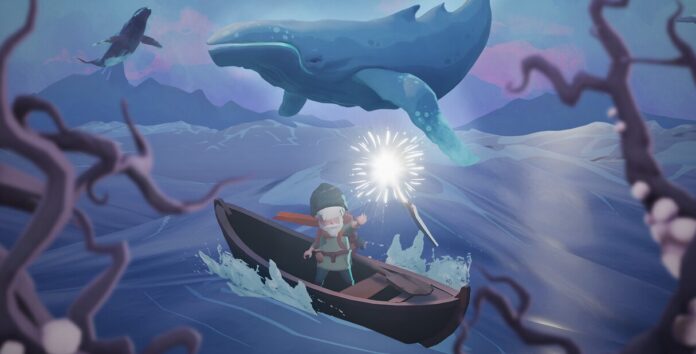Set in a beautiful, Slavic-inspired world, Selfloss by Kazakhstan-based indie studio Goodwin Games is an adventure that explores themes of grief, healing, and resilience. Developed by Aleksandr Khoroshavin (Alex Goodwin) and a small team, the game centers around an elderly healer named Kazimir, who journeys through a whale-worshiping fantasy land to heal his ‘soul wound’. Players use a magic staff to battle the dark Miasma overtaking the world. Reflecting on the game’s core concept, Khoroshavin shares, “The very first idea was that I want to make a game about an old protagonist that can traverse via boat. From there it grew into something much more.”
Kazimir’s staff is more than just a weapon, it’s a dynamic tool that players can use to solve puzzles, combat enemies, and cleanse the Miasma. The control mechanics are integral to the gameplay, allowing players to operate Kazimir and his staff both together and independently. “The way you control the old man and the magical staff at the same time is a neat mechanic that I am proud of,” Khoroshavin says. “Also, the boat traversal is quite unique.”
While Goodwin Games was officially founded in 2023, Selfloss has been in development since 2019, starting as a solo project led by Khoroshavin himself. In 2020, he was joined by his wife, Gorokhova Rita, who took on the role of 3D modeler and content lead. Later, Dmitriy Nakhabin, a former student of Khoroshavin’s joined the team. “I like being a team player now,” Khoroshavin reflects. “The advantage is that I can focus on the aspects of development I’m most passionate about, like storytelling, while the others handle areas I’m less comfortable with, such as modeling.”
Epic MegaGrant
Developing a game in Kazakhstan poses its own set of challenges, as Khoroshavin explains. “The indie game development community here in Almaty is almost non-existent,” he says. However, the lack of a local community hasn’t been a significant obstacle. “I used to attend a lot of game development events and conferences, but now I’m more interested in just focusing on making games.”

The development of Selfloss was initially funded by Khoroshavin himself through his job as a lecturer in game design and Unreal Engine at ITMO University in Saint Petersburg. Over time, he secured additional funding from various sources, including prize money from awards and an Epic MegaGrant. “The Epic MegaGrant was a game-changer,” he admits. “It gave me the financial security to better plan the development process and make progress without constantly worrying about funding.”
By 2021, Khoroshavin partnered with an investor, allowing him to further expand his vision for Selfloss. This financial backing gave the team the ability to focus on the creative and technical challenges without the constant burden of financial stress. “Having an investor who believes in the game has been incredibly supportive,” he shares.
Click in my heart
Selfloss stands out visually with a style that balances elegance with a folkloric, almost storybook quality. This unique aesthetic wasn’t predetermined but emerged gradually through experimentation and iteration. “I always knew I wanted Selfloss to have a somewhat cute, sweet look that would draw players in,” Khoroshavin says. “When I’m prototyping, I keep adjusting the visuals until I feel something click in my heart, when it feels like it’s beautiful.” This iterative approach to design led to a world that feels personal and intimate, something that fits Kazimir’s journey.

Khoroshavin is especially pleased with how each chapter of Selfloss is distinct in both appearance and feel, a design choice that keeps the experience fresh over its 6-10 hours of gameplay. “I’m really proud of the diversity across the game’s chapters,” he explains. “Each chapter looks and feels different, which keeps the pacing interesting and aligns with the narrative arc of Kazimir’s journey.”
Knowing the endpoint
Bringing Selfloss to completion was no small feat, particularly given the game’s length and complexity. “Finishing the game was the hardest part,” Khoroshavin admits. With an extensive narrative and unique settings, maintaining consistency across the game’s structure was a major challenge. However, he found that developing the game’s ending early on provided a valuable anchor. “Knowing the endpoint of the story was incredibly helpful,” Khoroshavin says. “It gave me a clear direction, which made tackling the challenges along the way feel more manageable.”

Reflecting on the development journey, Khoroshavin has come away with a valuable lesson: simplicity can be powerful. “The biggest lesson I learned is that I want to make smaller or more systematic games in the future,” he says. “Games that are intriguing based solely on their concept and a simple game loop.”
New prototypes
Despite Selfloss’s challenging sales performance since its release, Khoroshavin remains optimistic about the future. “Sales have been terrible, honestly,” he admits, but he is already exploring ideas for the next project. “We’re working on a few prototypes,” he reveals, adding that he regularly shares sneak peeks on social media. “But right now we don’t have a specific next game. We are trying to find it.”
Selfloss is out on PC, PlayStation, Xbox and Switch.

